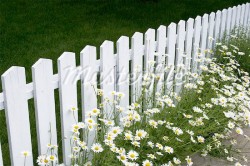
Garden fences are also used to provide a safe haven for the budding flowers and plants in the garden.
Once you measured the perimeter of your garden, choose the material of which garden fences are made. All existing garden fencing ideas may be divided into three groups: wooden garden fencing, metal garden fencing and plastic garden fencing. In any event, you need to “enliven” garden fence panels. Because the hedge is not only a decoration of your garden, but also very valuable from an environmental viewpoint, since plants produce oxygen, absorb carbon dioxide, hold back the wind and dust.
Some gardeners use the hop as a hedge, but are afraid to plant it near a wall of the house for it not to grow damp. These apprehensions are misplaced, as even after a rain, the wall remains dry – leaves of the hop shelter it as if by tiles. Especially beautiful are cones and red leaves of hops in summer and autumn when they entwine a metal garden fence or a decorative garden fence of the sitting area in your garden. It’s pleasant to sit in the arbour and breathe a fine and unique flavor of that plant!
It’s good when coniferous species of trees and shrubs grow in the garden. They create a special microclimate there; according to the experts, they hold back dust and emit many times more phytoncids than the hardwoods do. Experienced gardeners not only plant conifers along the garden fencing, but also create different compositions of them around the garden.
A playground can be fenced with a garden picket fence. 1-3 fruit trees (among which the apple is required) and pine or fir, on which you can hang toys in winter on New Year’s holiday, would look perfect.
If a tree hasn’t been bearing fruit for a long time, experienced gardeners deflect the branches at an angle of 45-60 degrees and fix them, tying to the trunk or special supports. Many owners of garden plots use the lunar calendar while planting fruit trees and ornamental plants in gardens and for hedges along the garden fence and around individual zones within the garden. For instance, plants the fruits of which lie above the ground – tomatoes, cabbage, cucumbers, fruit trees – are planted when the Moon waxes, and all the roots when it wanes. The time for reaping a harvest also depends on the phase of the Moon and also on the purpose for which you collect the gifts of nature. If you collect fruits for eating right on the table, it should be done when the Moon waxes: the fruits are juicy, rich in energy. For a long-term storage, the harvest is reaped in the Waning Moon. On the days of the New Moon it is not necessary either to plant or sow, only to weed. The grapevine, which is used frequently for “enlivening” the wire garden fencing and arbour, is cut just before the New Moon, otherwise it’ll “weep” for a long time.
Many gardeners, even with little experience in improving their plot, want to tell others about it. We’ll be happy if something from what you’ve read interest you and come in handy.
















